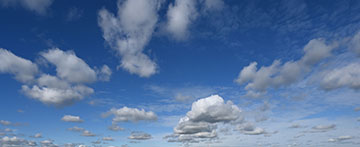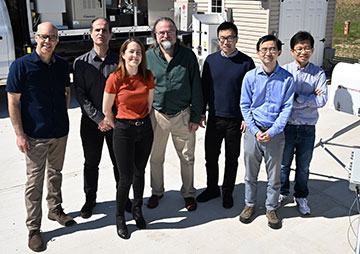
A novel lidar technique can image the vertical structure of clouds with sub-meter resolution [Image: Kevin Coughlin/Brookhaven National Laboratory]
A team of US researchers has shown that a new type of atmospheric lidar can probe the properties of clouds on length scales down to 10 cm―around 100 times better than can be achieved with conventional systems (npj Clim. Atmos. Sci., doi: 10.1038/s41612-024-00644-y). Such detailed remote monitoring is crucial to understanding the dynamics of droplet formation at the base of the cloud, which has an important effect on the evolution of clouds and their impact on the climate and the weather.
Better resolution
Cloud droplets are known to form around aerosol particles suspended in the atmosphere, but efforts to understand and predict this activation process have been hindered by the scarcity of observational data. Direct measurements can only be taken by an aircraft moving slowly through the clouds, a costly option that just provides a snapshot of cloud properties at a particular time and location. Ground-based lidar systems―which fire laser pulses into the air and then detect and analyze the backscattered signal―provide a more scalable alternative but do not resolve enough information to measure the formation of droplets and their subsequent growth within the cloud base.
In this new work, led by atmospheric scientists at Brookhaven National Laboratory, enhanced resolution is achieved through a novel time-gating technique. Rather than recording the full backscattered signal, the so-called T2 lidar measures returning photons within a very narrow time window, typically around 85 ns, which is comparable to the dead time of the detector. This means that the backscattered signal from a single laser pulse is likely to contain only a single photon, effectively enabling first-photon imaging of the cloud structure.

The team of researchers from Brookhaven National Laboratory [Image: Kevin Coughlin/Brookhaven National Laboratory]
New views of droplet formation
Varying the time delay between the initial laser pulse and the onset of the time-gated window allowed the team to sample different vertical sections of the cloud. Observations starting just below the cloud and extending around 120 m into the cloud base suggest that the air–cloud interface is not a sharp boundary, but a transition zone in which aerosol particles are transformed into progressively larger cloud droplets.
The researchers also developed an analytical model to estimate the concentration of cloud droplets at different heights through the cloud, producing results that were consistent with other model data. They now plan to improve the accuracy of the technique by calibrating the instrument's response with measurements from a lab-based cloud chamber. “Then we can take the lidar back out into the real atmosphere and be more confident in how our lidar measurements relate to cloud properties,” said study author Fan Yang.
